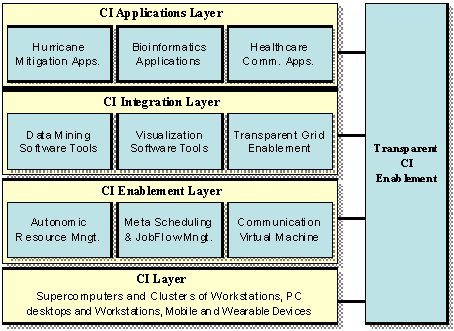Current tools used to create Cyberinfrastructure (CI) applications follow a bottom-up approach and present two problems: (1) they are either too generic and do not provide the right level of abstraction to allow experts in diverse domains to easily “code”
their application logic (e.g., CORBA, Web Services, and CASE Tools); or (2) they are too specific, in most cases following a stove-pipe development process, resulting in rigid and expensive solutions that do not promote the reuse of commonalities across domains. Our research aims to develop methodologies, platforms, and tools for better enabling CI applications in a way that eases the application development process and make resulting applications more adaptive to future changes of CI. Our approach is characterized as application-driven (hence “top-down”) by basing and focusing our investigation on (1) supporting CI-enablement for a few carefully chosen critical application domains, e.g. weather modeling, life sciences, and healthcare,
and (2) developing common methodologies, services and tools for developing CI-enabled applications in these domains. We hypothesize an enabling application development paradigm called Transparent Cyberinfrastructure Enablement (TCE), whose goal is to allow domain experts to effectively express the logic and software artifacts of domain applications while hiding the details of the CI architecture, software, and hardware stack. This TCE paradigm will serve as the foundation for the study of application development methodologies, platforms, and tools that will significantly ease CI-enabled application development (hence broadening CI utilization) and make applications more portable and adaptable to future changes of CI.
We believe that CI utilizing the TCE paradigm will be agile, flexible, and capable of serving a broad set of scientific and business communities.
FIU, FAU, and their partners have established a globally-integrated research and education program to respond to the above challenges and to realize TCE. We have identified three nationally-important domains of CI Applications: Bioinformatics, Healthcare, and Hurricane Mitigation. We have established a number of CI Integration projects that enable aggregation and discovery of data, visualization of data, and weaving of high-level CI enablement services into the logic of domain-specific applications. We have established several CI Enablement projects that provide a layer of abstraction on top of heterogeneous CI architectures by offering high-level services. 
Underrepresented students are engaged in these state-of-the-art and forward-looking research projects to extend their research and training experience by sending them abroad to collaborate with our international partners.
A unique opportunity to engage not only in computer science research topics focused on cyberinfrastructure enablement and integration, but will also expose participants to challenging cyberinfrastructure applications.

Synergy among the research projects
International teams conduct mutually complementary research projects and collectively support the goal of transparent CI application enablement. Projects will form CI application enabling platforms at different levels of abstraction. Projects in the CI Applications Layer will identify the requirements and provide methodologies, frameworks, and modeling tools that enable domain experts to model, design, and code their applications with minimal attachment to the underlying CI.
|

|
In designing and developing these “application interfaces,” common high-level, application-oriented functions, components, and tools are extracted and packaged into the CI Integration Layer, which provides services that can be reused by other applications in the targeted domains. The projects in the CI Enablement Layer will provide system-level services and tools to support efficient and transparent management and utilization of heterogeneous CI resources through uniform virtualized interfaces.
|
"PIRE... provides our students with the kind of
direct international experience and training that will
prepare them for careers in an increasingly competitive
global arena."
Dr. Modesto Maidique
President Emeritus, Florida International University "PIRE...will enable the next generation of
students participants to become fully engaged as members of
the globally-aware IT workforce.""
Dr. Nicholas Bowen
Vice President of Strategy and Worldwide
Operations, IBM Research "We look forward to hosting students researchers
... to foster our existing collaborations and create new
ones."
Mateo Valero Cortés
Director, Barcelona Supercomputing Center "I was able to develop quite a bit as a person, researcher, and professional."
Marlon Bright,
FIU student "Being able to learn elements directly related to my project, the likes and dislikes of another culture, and be able to communicate in a different language are all aspects related to the PIRE program for which I will always be grateful."
Simone Pasmore,
FAU student "It helps you build confidence that the degree you hold will enable you to tackle any problem, and, more importantly, it lets you experience the job before committing your life to it."
Allison Lanager,
FIU student |








